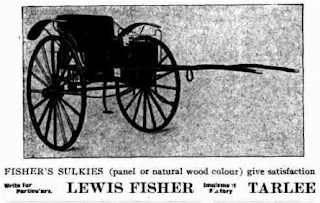The quarry at Tarlee
From 1929 onwards a chatty column entitled Out among the People was established at first in the The Register News-Pictorial (Adelaide, SA : 1929 - 1931) A similar heading and style of writing was carried through to several other newspapers including the Observer, the Advertiser and the Chronicle. This article from 1954 provides a brief outline of the uses of bluestone quarried just north of Tarlee.
Tarlee Bluestone
Talking of bluestone reminds us that this product of a Tarlee quarry has found favor in Adelaide. Even the little railway station building up there is a fine bit of work, as you will have noted when the north train passes through there.This bluestone has been used in the old Adelaide railway and many other stations, foundations for big Adelaide public buildings and kerbing stones in Adelaide streets.
I have since learnt that it can be seen in the wall round Whinham College, North Adelaide.
Mr. Buckley told me that 100 men worked in the Tarlee quarry. Its stone was used in the rather nice Catholic Church at Tarlee. That stone, he said, was first carted to Gilbert Town, not far up the road.
'The old Gilbert Hotel was there,' he explained. 'You can see the letter G in the mileposts from here to Clare Bowmans owned the paddock the hotel was on; Mclnerneys own it now.
Next, the stone was transferred to Navan, between Riverton and Tarlee. Then the Archbishop decided the church should be at Tarlee. Mr Colbert gave the land for it.'
1954 'Out among the People', Chronicle (Adelaide, SA : 1895 - 1954), 27 May, p. 55. , viewed 23 Apr 2019, http://nla.gov.au/nla.news-article93913055
Further back in time - 1899
One of the earlier mentions of work at the quarry, 1899, indicated that stone was being used for kerbing in Adelaide and significant buillding projects.1889 'TARLEE, August 10.', Kapunda Herald (SA : 1878 - 1951), 13 August, p. 3. , viewed 23 Apr 2019, http://nla.gov.au/nla.news-article108349698Work has been resumed in the Tarlee quarry and a great quantity of Stone is being removed, making work for a number of the unemployed in the township. The stone, I believe, is being conveyed to Islington for building the Government work shops. For building purposes this stone has a great reputation. A great quantity, I understand, was us»d in building' the new Parliament House, beside other large buildings in different parts of the colony.
Tarlee, a small town, a large contribution to the South Australia's buildings and roads.



